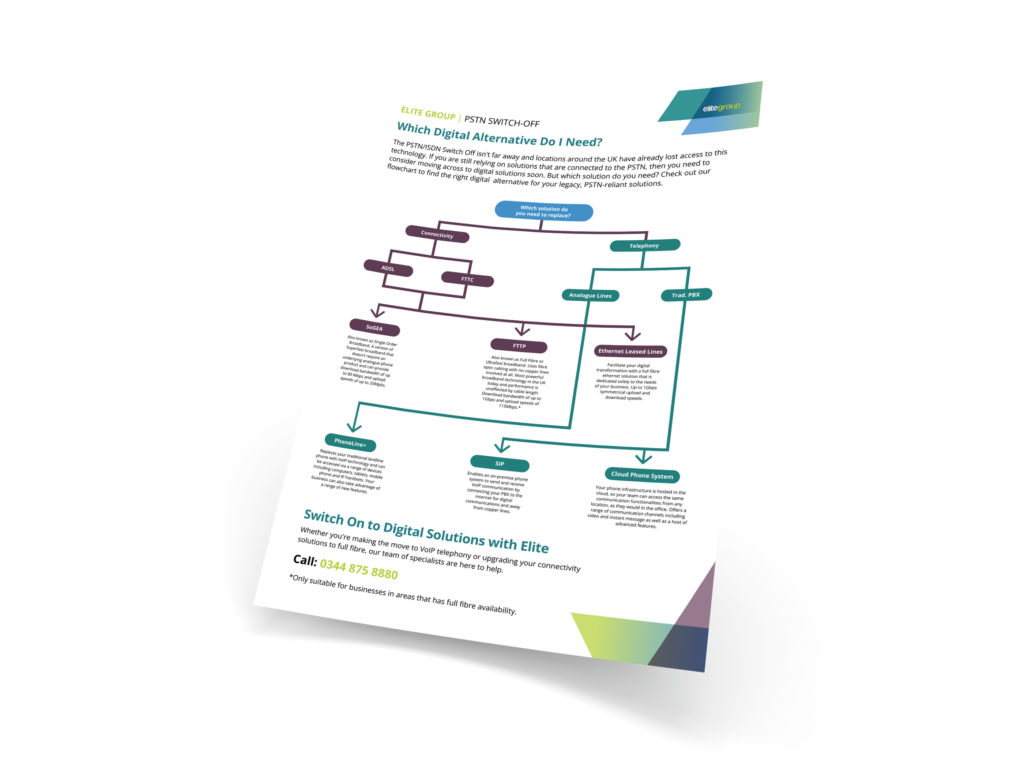Navigating Travel Industry Risks with Intelligent Communications
We’re going to explore some real-life unforeseen circumstances that the travel industry has had to navigate and how intelligent communications solut...
The PSTN is the network of analogue lines that has formed the infrastructure for our telecoms for decades and uses the same technological basis as the network that supported the conception of the telephone! Sadly, old age comes to us all and this network isn’t built to support the modern communications we’re utilising today. So, Openreach have made the decision to retire these old faithful analogue lines by December 2025 to make way for fully digital communication via the internet. With only two years to go, it’s critical that businesses who are still relying on the PSTN for their communication or connectivity prepare their business by seeking new digital alternatives to this outdated technology.
We’ve already helped many businesses make a seamless transition from outdated, PSTN services to new, fully digital solutions. So, we’re outlined the 5 key steps your business can take to successfully prepare your business for the PSTN switch off and implementing digital alternatives. Whether you’re looking to find out what the PSTN actually is and what it means for your business or you’re looking to research or your options, you’ll find out everything you need to know in this article.
PSTN stands for Public Switched Telephone Network, which is made up of analogue, copper cables that was initially installed to support traditional telephony services. In the late 1980s, our communication and connectivity requirements had progressed and the ISDN (Integrated Services Digital Network) was introduced, which used digital transmission to make calls and transmit data over the circuits of the traditional PSTN.
To give you an idea of the chronology of this technology, we’re going to split up these networks into generations. The traditional, copper-based PSTN are the oldest, so let’s call them the ‘boomer’ of communication technology. It uses the same principles as the first ever public phone network, where analogue voice data flows through the circuit-switched copper phone lines. The ISDN is an 80’s baby, making it the ‘millennial’ of the telecommunications technology.
Although the ISDN does provide better voice quality than the PSTN, it is also becoming outdated and isn’t capable of meeting the demands of modern communication solutions effectively. Furthermore, as it relies on the PSTN network, it will also become obsolete when the PSTN is switched off. Remember dial-up internet? It was once possible to utilise analogue PSTN connections to support dial-up internet, but this capability was slow and became obsolete with the introduction of broadband internet services. ISDN was the go-to option for video conferencing and fast internet connections in days gone by, but it has now since been overtaken by more modern innovations like fibre broadband.
In 2017, Openreach announced that they were switching off the PSTN network, which means that all PSTN and ISDN lines that have powered communications and legacy connectivity solutions for decades would become obsolete. Transferring voice calls to an internet-based, fully digital network relies on decent connectivity, so the next step was for Openreach to pledge in 2018 to improve their network, in order for fibre broadband to become more accessible. From 5th September 2023 the national WLR (wholesale line rental) stop sell was put in place, which prevented businesses from ordering, moving or amending any WLR phone line or broadband service, anywhere in the UK, as this technology will become obsolete when the PSTN switch off happens. If businesses are looking to purchase new communication technology, they will need to invest in new, digital solutions instead and all businesses who are operating Openreach has set a deadline for the PSTN to be fully phased out for December 2025, which has since been switched out for January 2027.
So, what does the PSTN Switch-off mean for your business? If you’re still relying on legacy PBX telephony solutions that utilise the PSTN, you will need to switch over to fully digital, VoIP telephony solutions. If your business relies on legacy, on-premise connectivity solutions, like ADSL, this will also become obsolete and will need to be replaced by a full fibre solution.
Find out which solutions will be switched off with the PSTN and their alternative solutions, by checking out our guide here:

According to a survey by National Business Communications demonstrated that 62.1% of UK businesses still use PSTN-reliant, legacy phone systems or connectivity solutions. It’s key to take into consideration that the Switch-off is not a one-time event. There isn’t an engineer with a hand hovering over a big switch, ready to turn the whole PSTN off in one go. It’s a gradual process, where the network will be switched off location, by location with an overarching deadline of December 2025. So, the good news is you have time to consider your options – but not a lot of it. Making the move to digital solutions, sooner rather than later is a smart move, as your business will have plenty of time to ensure a seamless transition and for your team to adjust to your new solution. Leave it too late and you could run the risk of rushing into a purchasing decision and be left with a solution that isn’t a perfect fit for your business or not allowing your team enough time to find out how to get the most out of your new system. If your business is still relying on legacy communication solutions or older internet connections, you’re making a great first step by reading this article.
When PSTN was first introduced – and when ISDN soon followed – the only requirement these lines had was to carry the voice signals of individuals calling each other on the phone, which by today’s standards requires barely any data whatsoever. The amount of data being shared back then was a mere drop in the ocean compared to the amount of data that is shared today. With many companies adopting cloud-based systems that rely on consistent and effective transfers of data, including in communications, the PSTN lines are no longer equipped to manage the sheer volume of megabytes, gigabytes and terabytes of data being produced and transferred every single day.
Digital solutions powered by VOIP, on the other hand, do not rely on physical lines, instead relying solely on an internet connection – which is far more effective in handling this constant stream of data. With modern improvements in internet technology, like full-fibre connections, people and businesses can enjoy lightning-fast and reliable communications and data transfers while not being encumbered by the limitations of the old copper lines.

Analogue phone lines, while incredible for their time, are nowhere near as impressive in the quality of the calls they’re able to deliver, compared to modern digital alternatives. As voice signals are converted into digital signals using VOIP, calls are far clearer and crisper, as opposed to traditional phone line calls. With HD calling, callers can be heard and understood more effectively by call handlers, allowing the handlers to better serve their customers and their needs, without struggling to understand what they are saying.
Call recording is a useful tool, allowing businesses to play back their calls in the event important information needs to be recalled, or facts need to be straightened out between callers and businesses – along with the expected “training and quality purposes.” Historically, analogue calls have been difficult to record compared to digital VOIP calls which, when paired with an internet-based communications system, are easy to record, view, manage and transfer. This means calls can be relayed and listened to by the appropriate people within the business faster, boosting productivity.
Traditional copper phone lines aren’t just ineffective in handling modern data demands, they’re also incredibly expensive to install, repair and maintain. Businesses that rely on the traditional lines are forced to install new lines whenever a new member of staff (who requires their own phone) joins the team. This can be expensive, laborious and time-consuming, as well as requiring an engineer to visit the site to make the necessary changes. Whereas a communications system utilising VOIP only needs to add a new user to the system and install the relevant software to their devices, for them to be able to communicate with their fellow workers and customers – a far cheaper and more practical alternative.
VOIP-based systems are also incredibly flexible compared to legacy systems. While being able to add potentially hundreds or thousands of users within minutes (if the bandwidth is able to sustain the traffic), they’re also incredibly useful for remote workers based outside of the office. By logging into the same communications system from home – or wherever they happen to be – workers can still have calls transferred to them and communicate with their colleagues and customers effectively with virtually zero disruption.

So, now we’ve covered pretty much everything you need to know about the PSTN, the switch-off and your potential options, let’s jump into the five steps that are going to make your transition to IP telephony a breeze. Ready? Let’s go!
This is the most important step before you do anything else – that’s why it’s number 1! As digital voice services rely on a stable internet connection, ensuring that your connectivity solutions are up to the task of supporting the extra pressure caused by digital voice services is key. If your current internet connection isn’t capable of supporting IP telephony, your call quality will suffer. In addition, if you’re thinking of implementing a solution, such as a hosted phone system, that relies on the cloud, this is going to be heavily reliant on high-quality internet connectivity.
Poor voice quality and buffering video calls are going to be two irritating symptoms your communications will suffer from if your bandwidth and connection speed isn’t up to the job. These problems will have a knock on effect with the productivity and morale of your team, as well as the experience of your customers. Also if your internet connection is reliant on the PSTN, this will also need to be replaced, as well as your legacy phone system. Rather than investing in a new VoIP phone system and seeing if your connectivity can cope, after installation, it is important that you audit your internet connection now and sort out any issues or replace your internet solutions with a suitable alternative now.
In addition, as technology progresses, your business’s reliance on the internet is only going to grow. So, it’s important when assessing your connectivity solutions, to ensure that they are suitable for both today and for the future. Prevention is always better (and more cost-effective) than cure!
Read more: Is Your Internet Connection Good Enough to Deliver VoIP?
Now you’ve analysed how effective your connectivity is, the time has come to pick your solution. Which is going to be best for your business? The answer is whichever best suits your business’s needs. You will need to analyse your business operations, how you currently use your phone system and how you want to improve your business in the future, as well as evaluate the benefits and drawbacks of potential solutions. As a starting point, here is a quick comparison of SIP trunking and hosted phone systems – two powerful, alternative solutions for PSTN reliant phone systems.
One of the biggest factors you may have to consider when picking your IP voice solution is the degree of control you will want over your solution. With a hosted phone system, the provider will maintain a higher level of control, which is great from a maintenance perspective, as your provider will be responsible for it. Furthermore, there is a lot of scope for customisation to personalise your solution for your business. Installation is a simple processes, with minimal onsite equipment. This is a great option for businesses who don’t have the resource to manage their business phone system themselves. However, you will have minimal control over your hosted phone system, which is a concern for some businesses depending on the nature of their operations. Although hosted phone systems do include security measures, for some businesses not having complete control over their phone system can pose an issue for their operations. If
In comparison, although it can be a more expensive option than a hosted phone system, in some cases, SIP trunking can offer a higher level of control for businesses. You can maintain your current PBX equipment and use an analogue adapter or SIP-to-T1 gateway to reduce costs. You will, however, need to have access to an in-house team to manage, maintain and make any necessary changes to the solution.
Read more: Hosted PBX vs SIP Trunks – Which is Better?
Switching to VoIP telephony doesn’t necessarily mean that you have to swap out all of your handsets and buy a completely new set. It is possible to convert compatible handsets with an adapter, meaning you can continue to use the same hardware and reduce costs. However, this isn’t the case with all handsets, so it’s important that you analyse the hardware you currently have and how your team utilises it to gain insights into the hardware you need – if any.
With ‘softphone’ capabilities, provided by VoIP telephony, you will be able to use devices, such as laptops, tablets and PCs to make calls, which removes the need for every member of your team to have access to a desk phone. When it comes to solutions like UCaaS (unified communications as a service) your phone systems is accessed via a platform that can be used on a range of devices, including mobiles and laptops. Alternatively, after analysing your handsets, you may discover that your team will benefit from a combination of VoIP desk phones and ‘softphones.
At the end of the day, your business’s needs are unique, so make sure you take the time to investigate the amount and type of handsets your team actually requires. Not only could this save you money, it means that your team has access to the right tools to maximise the benefits of your new VoIP telephony solution.
Once you’ve analysed the type of solution and hardware that your business needs and you’ve figured out the best way to solve any connectivity issues, the next step is to research and compare solutions and their respective providers in order ensure you’re purchasing the solution that will bring the most value to your business. Whether it’s full fibre connectivity solutions or a VoIP business phone system, there are a lot of alternative products on the market that possess a range of different options and features, depending on the provider. Contract terms and lengths, connection quality and handset capabilities will also vary, so to ensure you’re getting the best deal and the right features for your business, dedicating a suitable amount of time to research different providers is really important.
When searching for the right provider, there are some key factors to consider to help you choose the best fit for your business. Firstly, find out how many years of industry experience the provider possesses. If they are a well-established company that has been around for a good amount of time, they will gained experience successfully migrating businesses like yours away from legacy solutions and onto more up-to-date technology. You will also be able to benefit from expert specialists who have extensive industry knowledge gained over years working within the technology industry.
Another key factor to consider when choosing a technology provider, is their accreditations. The best providers will hold accreditations and high-level partner status with big technology brands, and these accreditations are a testament to the knowledge and service those providers offer. Again, this demonstrates the trust that big brands have in the provider’s knowledge, which means you’re in the hands of a provider who not only knows how the products function and their benefits, but how to implement them, effectively, within your business.
As with many business changes, training is fundamental to ensure users are gaining the most value from your new investment and using it to effectively support your customers. However, encouraging your team to be enthusiastic about your new digital solutions is just as important as ensuring their understanding of the new systems. Now, you may be thinking, how exciting can you make a business telephone system or full fibre connectivity solution seem? The key is highlighting how this new solution will make aspects of their responsibilities easier, but also improve them. Show your team how your new VoIP solution streamlines communications, prevents the risk of dropped calls, having all of their contacts in one place, enables better productivity and collaboration. Show how they can save time that can then be reinvested into time-consuming tasks, so they will be less stressed managing their workload.
The key step in getting your team on board with your new solution is to, firstly, find out everything there is to know about your solution – from it’s features and benefits to basic troubleshooting. Your provider may be able to provide a training session to show you the ropes of your new solution.
Once you’re clued up, take time to sit your team down and go through the new voice solution with them, ensuring you cover:

At Elite Group, we have everything you need to make the switch from PSTN solutions to VoIP telephony and full-fibre connectivity solutions. From SIP Trunking to FTTP internet connectivity and feature-rich UCaaS solutions, as well as handsets and business mobile phone solutions, we can help prepare your business for the future beyond the PSTN. Our team of specialists are accredited by the biggest brands in the industry, including Mitel, 8×8 and Microsoft and will work with you to identify the needs of your business in order to find the perfect digital alternative to your current solutions. Migration is seamless and straightforward, as we will work with you throughout the process to ensure that all deadlines are met, disruption is mitigated and you can spend more time discovering the benefits your new solution will provide.
Once you’ve found your perfect solution, you will be assigned your own personal, named account manager who will be responsible for managing your contract, ensuring your solution is always providing the best value and answering any questions you have. Whatever you need to make the switch, we’re here with best-in-class digital solutions, coupled with expert service and speedy support.
If you’re ready to make the switch, contact us today or call our specialists on 0344 875 8880 for a free consultation.
How to Choose the Best VoIP Service
How Legacy Technology Costs Your Business Money